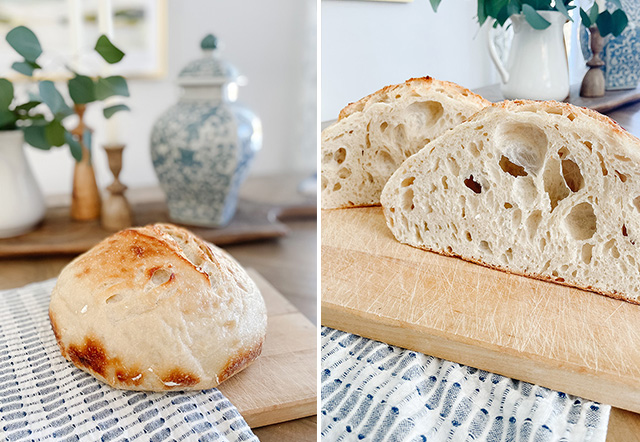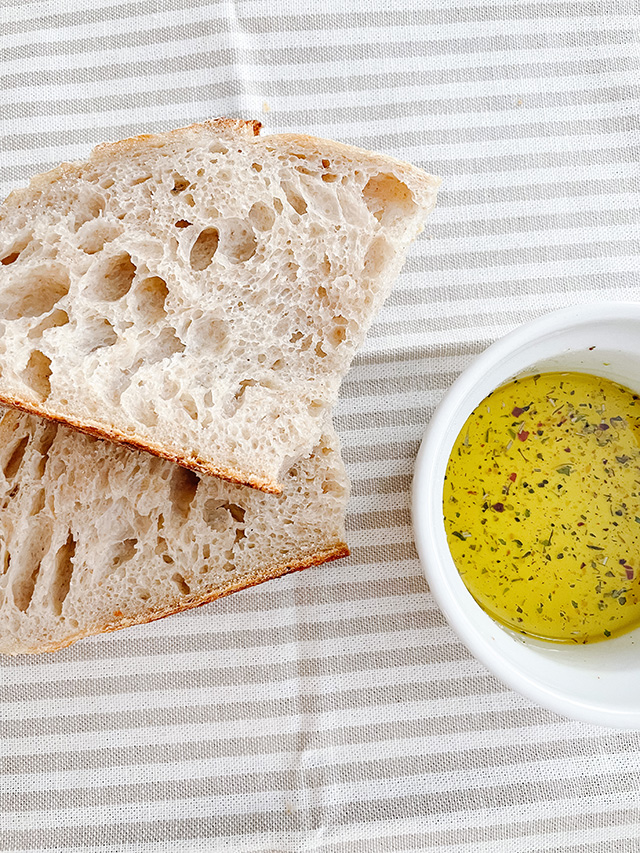+ Lame: scoring tool to create the patterns on the top of your loaf.
After weeks of tweaking things, this loaf below is when I finally hit my groove. I decided to use less whole wheat flour, a little more starter in the recipe, and finally perfected the proofing time AND learned an important technique in shaping (spoiler alert: shape it twice!) THIS is what you call an "open crumb" and from what I've read and seen, it's the ideal crumb ;)

MY SOURDOUGH RECIPE
Day One
1. FEED your starter (if you haven't baked recently, feed it twice) before baking, making sure it’s healthy and bubbling, has doubled in size since feeding. Do the “float test” to be sure it’s ready to use-- fill a glass of water and drop 1 tsp of starter in the stop. If it floats, it’s ready to use. If it sinks, it needs more time.
This is how your starter will look right after feeding. The rubber band is placed at the level of the starter, so we can tell when it has doubled in size.
This is what your starter will look like in a healthy, bubbly and active (ready to use!) state, usually about 4-6 hours after feeding:
2. Make your “SPONGE”. In the evening, after feeding it for the second time and making sure it's healthy and bubbling, mix the following together with a rubber spatula:
90g starter
120g whole wheat flour
120 g filtered, lukewarm water
*Cover with plastic wrap and set on counter overnight
This is what it will look like when you first mix it up:
This is what your sponge will look like the next day (it will have more than doubled and have some bubbles like this-- that's what you want.)
Day Two
3. DOUGH. The next day (I start in the afternoon, but just pick a time where once you start this process, you can finish it all at once, following the timing with each step) we’ll mix up our bread dough and do a lot of folding / kneading.
(NOTE: weather plays a huge role in your dough texture and consistency. If it's warm or humid outside or in your home, you'll want to use ~20-30g LESS of water. If it's really cold and dry, you may need to add a bit more water to your dough before the first stretch and fold. This is all noted below.)
- Add 750g filtered, lukewarm water to the overnight sponge. Mix with a whisk until completely dissolved in its own bowl. *If it's warm/humid where you live, do 730g of water here. Adjust the recipe next time according to what you find worked with your weather.
- In a large bowl, measure out 800g bread flour & 200g whole wheat flour (if you’re only using white bread flour, use 1000g of it-- this is what I've been doing lately and it's been incredibly tasty!). Pour the previously mixed overnight sponge & water mixture into the flour bowl. Mix all of this together with your hands, removing jewelry. This will be very sticky-- that’s expected!
*Once mixed set aside with towel covering bowl for 50 minutes.
4. SALT + FOLDING. After 50 min of resting, add 22g of salt to the top of your dough, then pour another 50g of lukewarm water on the top (only add this extra water if it's dry and cold outside. If it's hot / humid, cut this back to 20g, or completely omit) and fold it in using the “stretch and fold to the middle” method, described below.
To fold, gently start on top like a clock. Using wet hands, stretch the dough up and then fold the top to the center. Turn the bowl ¼ turn and repeat until you've done 4 folds (this is how you’ll fold each time the recipe says "fold"). You will do 4 folds/rotations of the bowl in total, each time you fold. It only takes about 30 seconds each time you do it.
*Let the dough sit, covered for 30 minutes.
5. After 30 min, fold again.
Wait 20 min
Fold again
Wait 20
Fold again
Wait 20
Fold again
*You will do 5 folds with ~20 minutes in between each fold. (I have found that folding it just 3 times works as well, too, if my timing doesn’t allow the extra hour.)
These photos illustrate the progression of what the dough will look like after folding:
Left is after mixing the dough. Right is after the first fold. You can see it's more watery because of the extra water we add on top, if needed.
6. After the last fold, let it sit to proof, covered with plastic wrap and a towel, then left somewhere that is evenly warm. I have found around ~75 degrees is best. Do not set it in front of a fireplace where it will heat unevenly. Sitting it in a room with a space heater or while laundry is in the dryer, or a warm storage room is a great idea. At this temp, it has usually doubled in size, which is what we want, by 2.5-3ish hours of resting. This will vary based on temp and humidity levels. The most important thing is that your dough has doubled in size and is pulling away from the edges of the bowl. It should also be quite bouncy. When you poke it, the dough should spring back and not leave a dent. This could take anywhere from 2-5 hours, so be sure to check it! On warm days, this will take a lot less time to happen than on cold days. Outside weather plays a huge role in your dough!
7. SHAPING & PROOFING. Our last step of Day Two is to grab two bowls or flour-dusted proofing bannetons. Place parchment paper in bowls if not using proofing baskets and spray them with a non-stick spray to help the dough not stick. If using bannetons, lightly dust them with flour.
Dust your clean countertop with the flour you used for your dough.
Dump your dough out using the help of your dough scraper, and split the dough in half. This recipe makes TWO large loaves.
Working with one half of the dough, begin to shape your bread into the form you want it to bake in. I always make mine into round (boule) loaves. I recommend this shaping tutorial and then this one, where he teaches to shape twice. This has been game-changing in my shaping! Once you've shaped it once, place it in the proofing bowl (you put your loaf in the banneton with the bottom of your loaf facing up) with plastic wrap on top for 15 minutes. Repeat bread shaping technique one more time, then place it back in the bowl.
Place in fridge, covered with plastic wrap and a towel.
Day Three
8. PREPARE TO BAKE. Baking is the easy part! Preheat to 475. During the last 10 minutes of preheating, place your Dutch Oven inside the oven to also heat up. Once it’s preheated, remove the Dutch Oven carefully.
This is what your dough should look like right out of the fridge:
9. SCORE. This refers to using an oiled, sharp knife, or bread lame, to cut a design or slit in the top of the bread. This allows the bread to open and rise in intentional places and it’s also quite beautiful! (Google scoring patterns if you want to get creative, otherwise one simple line down the middle or an X shape will do!)
Dust the dough with flour before scoring. I use a flour sifter to do this. Gently rub the flour into the bread evenly.
10. Move your newly scored dough to the (hot) Dutch Oven by lifting the parchment paper and transferring it.
11. BAKE!
* 26 minutes with lid on at 475 degrees.
* Lower oven temp to 450 and remove lid and bake 13 minutes with lid off, until browned. This is the perfect amount of time for an easily chewable crust. If you want a crunchier crust, bake for 5-8 minutes longer without the lid.
12. LET IT COOL. I know, this is really hard at this point in the process. But apparently the steam inside the bread is still doing its thing, so leave it to cool for at least 1.5 hours, then enjoy :)
TO STORE: You can store it wrapped in a dish towel, sitting out on our counter, with the cut side face down on the counter for a crunchier crust. You can store it in a ziplock bag as well, but it will get softer and lose the crunch. This is what we do though, because we use it for sandwich bread often. Your call based on preference!
TO FREEZE: sourdough freezes really well! Just wrap it in foil first, then put it in an airtight bag and freeze. To thaw, set it out on the counter about 2 hours before you want to serve it (out of the foil and bag).
+ Is your bread not rising? You probably need to let it proof longer (the most important thing is to make sure it's doubled in size and is pulling away from the edges of your bowl!) in a warm setting and make sure the starter is active and bubbly when you use it. Be sure you're using lukewarm, filtered or bottled water in the recipe and any time you feed the starter. Make sure your dough is covered well when proofing so it doesn't develop an outer layer of crust. Finally, increased steam helps your loaf rise, so adding a couple ice cubes in your Dutch Oven is super helpful!
+ Is your bread dense and gummy? This is one of the most common problems and it happened to me in my first few bakes. It comes down to not letting it proof as long as it needs to and having an inactive starter. Fix those two things and you'll be on your way!
+ Does your bread not have enough flavor for you? Be sure you added the salt ;) and you can play around with the amount of starter that is in your recipe. This recipe originally called for 40 grams, but I upped it to 90g in order to increase the sour flavor (more starter also decreases the amount of time it'll take to proof, as it accelerates the process). Finally, the longer you go without feeding your starter, the more sour it will taste, so if you like the sour taste, stick it in your fridge while you're not using it and only pull it out to bake with. This is what I do!
+ The bottom of my loaf is burnt, how do I prevent that? Some recipes tell you to preheat the Dutch Oven for an hour before baking and when I did this, it burned the bottom of the loaf, so now I only preheat the Dutch Oven while the oven is preheating.
Happy Baking





























